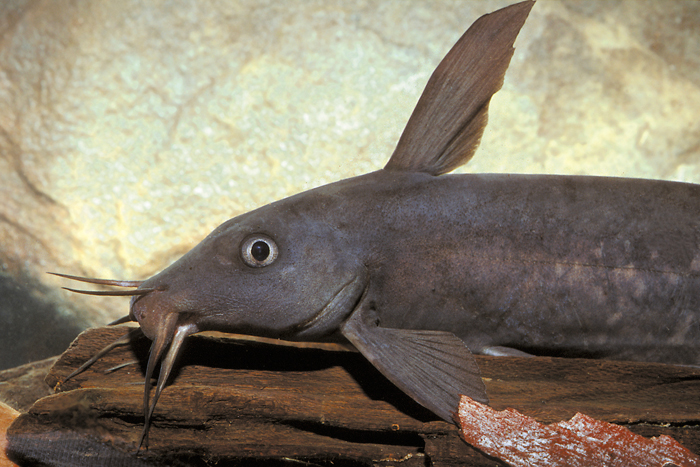- Classification
- ACTINOPTERYGII
- SILURIFORMES
- PLOTOSIDAE
- Neosilurus
- pseudospinosus
Falsespine Catfish, Neosilurus pseudospinosus Allen & Feinberg 1998

Falsespine Catfish, Neosilurus pseudospinosus. Source: Gerald R. Allen / Western Australian Museum. License: All rights reserved
Falsespine Catfish, Neosilurus pseudospinosus Allen & Feinberg 1998
More Info
|
Distribution |
Widespread in tropical creeks and rivers of the Kimberley region of Western Australia, to the Victoria River system of the Northern Territory. Falsespine Catfish inhabit streams and rocky pools in slow to swiftly flowing water. Individuals swim close to the bottom. |
|
Features |
Dorsal fin I, 4; Anal fin 71-83; Caudal fin 8-10; Pectoral fin I, 11-13; Pelvic fin 13-15; Dorsal-Caudal-Anal rays 109-136;gill rakers 5-8 + 12-16; Vertebrae 49-52; Branchiostegal rays 8-10.
Body elongate and tapering posteriorly; head more or less conical but flattened on ventral surface; dorsal profile of head nearly straight, slightly arched; snout pointed in lateral view; mouth subterminal; lips fleshy; anterior nostril forming a low rimmed tube on upper lip; posterior nostril a narrow slit immediately behind nasal barbel; eyes relatively small; nasal barbel almost reaches to eye; maxillary and outer mental barbels approximately equal, reaching to gill margin; inner metal barbel slightly shorter; slender conical teeth in upper and lower jaws, with lunate patch of larger conical teeth on palate; branchiostegal rays 8-10. Scales absent, covered in smooth skin. Dorsal and pectoral fin spines weak and flexible; 1st dorsal fin small but tall, tip pointed, originating in front of level of ventral fins ; 2nd dorsal confluent with caudal and anal fins, originating far back near end of body; pectoral fins inserted just behind opercular margin, tips pointed. |
|
Size |
Maximum size to about 35 cm. |
|
Colour |
Usually dark grey to blacksh (sometimes mottled), with black fins and a pale underside. |
|
Feeding |
Feeds on terrestrial and aquatic insects, crustaceans, molluscs, detritus and algae. |
|
Biology |
Little is known of the reproductive biology of this species. Spawning is likely to occur during the wet season. |
|
Similar Species |
Closely resembles the Softspine Catfish, Neosilurus mollespiculum, which also lacks rigid dorsal and pectoral spines, but has longer nasal barbels than the Softspine Catfish. |
|
Etymology |
The specific name pseudospinosus refers to the characteristic soft, flexible dorsal spine. |
|
Species Citation |
Neosilurus pseudospinosus Allen & Feinberg 1998, Aqua, J. Ichthyol. Aquat. Biol. 3(1): 15, figs 4-5. Type locality: Rocky pool of Ord River on Old Lissadel Station, Kimberley District, WA [16°40’S, 128°83’E] |
|
Author |
Gomon, M.F. & Bray, D.J. 2019 |
|
Resources |
Falsespine Catfish, Neosilurus pseudospinosus Allen & Feinberg 1998
References
Allen, G.R. 1988. Freshwater Fishes of Australia. An annotated checklist. Ringwood, Victoria, Australia : New Guinea Fishes Association, Ringwood, Victoria : 8 pp. (as Neosilurus sp. C)
Allen, G.R. 1989. Freshwater Fishes of Australia. Neptune, New Jersey : T.F.H. Publications 240 pp., 63 pls.
Allen, G.R. & Feinberg, M.N. 1998. Descriptions of a new genus and four new species of freshwater catfishes (Plotosidae) from Australia. Aqua, Journal of Ichthyology and Aquatic Biology 3(1): 9-18 figs 1-6
Allen, G.R., Midgley, S.H. & Allen, M. 2002. Field Guide to the Freshwater Fishes of Australia. Perth : Western Australian Museum 394 pp.
Ferraris, C.J. 2007. Checklist of catfishes, recent and fossil (Osteichthyes: Siluriformes), and catalogue of siluriform primary types. Zootaxa 1418: 1–628
Morgan, D.L., Allen, G.R., Pusey, B.J. & Burrows, D.W. 2011. A review of the freshwater fishes of the Kimberley region of Western Australia. Zootaxa 2816: 1-64
Morgan, D.L., Allen, M.G., Bedford, P. & Horstman, M. 2004. Fish fauna of the Fitzroy River in the Kimberley region of Western Australia – including the Bunuba, Gooniyandi, Ngarinyin, Nyikina and Walmajarii Aboriginal names. Records of the Western Australian Museum 22: 147-161
Unmack, P.J. 2001. Biogeography of Australian freshwater fishes. Journal of Biogeography 28: 1053-1089


